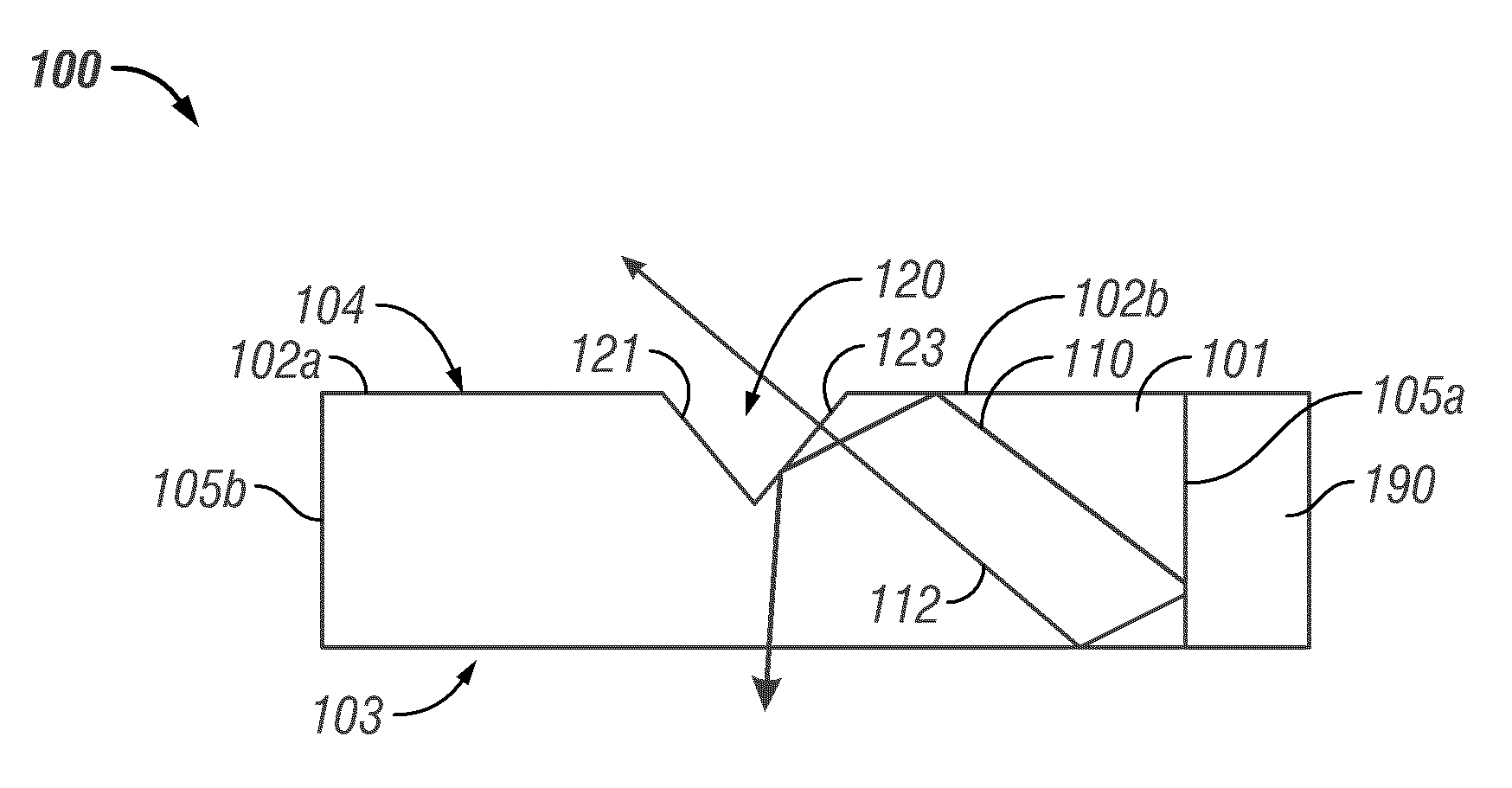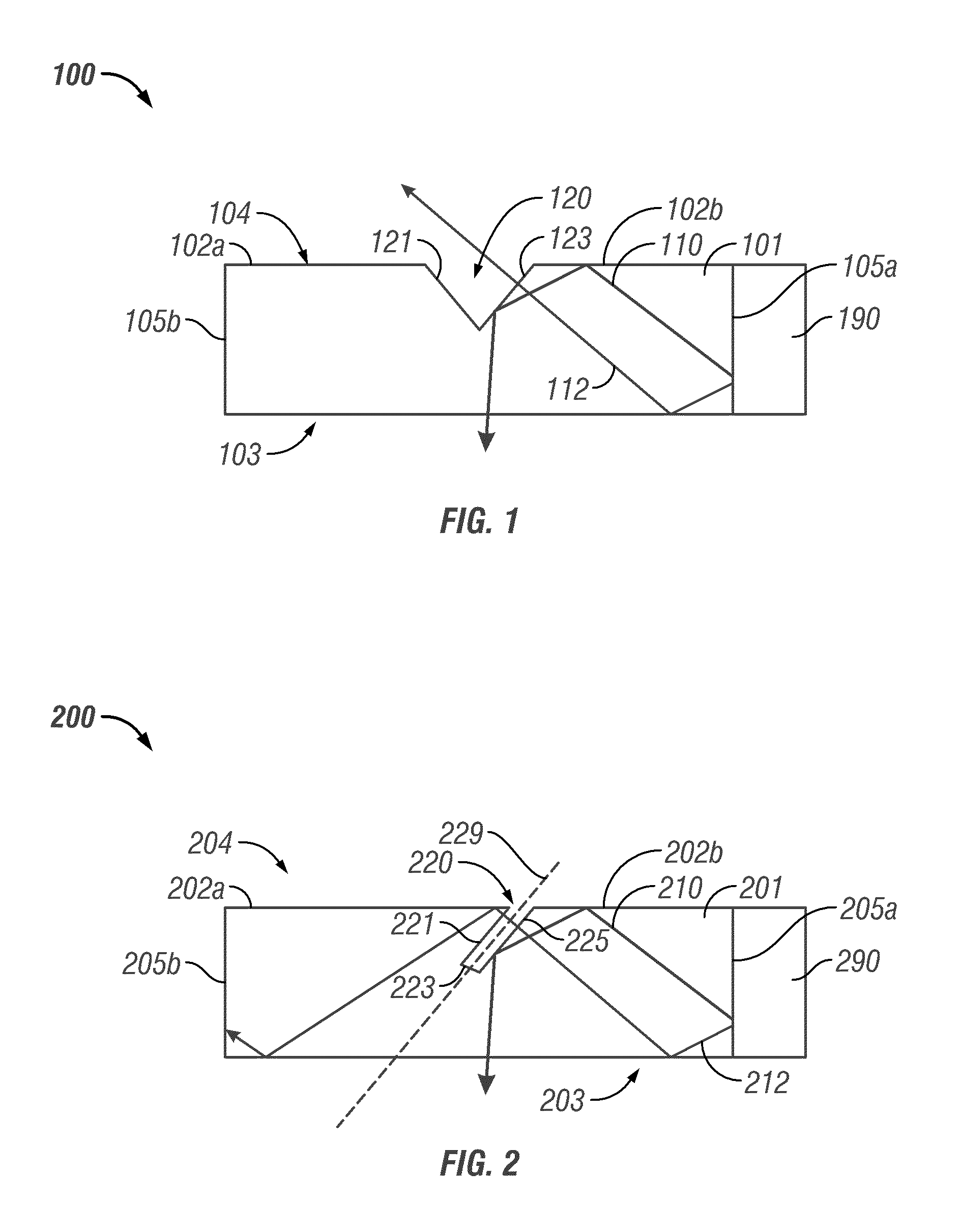Methods of manufacturing illumination systems
a technology of illumination system and manufacturing method, applied in the field of lighting, can solve the problems of inefficiency of machined or embossed features, limited installation and use of panel lighting force,
- Summary
- Abstract
- Description
- Claims
- Application Information
AI Technical Summary
Benefits of technology
Problems solved by technology
Method used
Image
Examples
first embodiment
[0020]FIG. 3A is a cross-section of a base layer used to manufacture an illumination system having a plurality of re-entrant turning features.
[0021]FIG. 3B is a cross-section of a cover layer used to manufacture the first embodiment of an illumination system.
[0022]FIG. 3C is a cross-section of the base layer of FIG. 3A shown with the cover layer of FIG. 3B with a coupling layer applied to the cover layer.
[0023]FIG. 3D is a cross-section of the first embodiment of an illumination system having a plurality of re-entrant turning features formed between the cover layer of FIG. 3B and the base layer of FIG. 3A.
[0024]FIG. 3E is a block diagram schematically illustrating an embodiment of a method of manufacturing the light panel schematically illustrated in FIG. 3D.
second embodiment
[0025]FIG. 4A is a cross-section of a base layer used to manufacture an illumination system having a plurality of re-entrant turning features.
[0026]FIG. 4B is a cross-section of a prismatic block used to manufacture the second embodiment of an illumination system.
[0027]FIG. 4C is a cross-section of a set of prismatic blocks from FIG. 4B shown with the base layer of FIG. 4A and a coupling layer applied to each of the plurality of prismatic blocks.
[0028]FIG. 4D is a cross-section of the second embodiment of an illumination system having a plurality of re-entrant turning features formed between the prismatic blocks of FIG. 4B and the base layer of FIG. 4A.
[0029]FIG. 4E is a block diagram schematically illustrating an embodiment of a method of manufacturing the light panel schematically illustrated in FIG. 4D.
third embodiment
[0030]FIG. 5A is a cross-section of a base layer used to manufacture an illumination system having a plurality of re-entrant turning features.
[0031]FIG. 5B is a cross-section of a first prismatic block used to manufacture the third embodiment of an illumination system.
[0032]FIG. 5C is a cross-section of a second prismatic block used to manufacture the third embodiment of an illumination system.
[0033]FIG. 5D is a cross-section of a set of the first prismatic blocks from FIG. 5B and the second prismatic blocks from FIG. 5C shown with the base layer of FIG. 5A and a coupling layer applied to each of the prismatic blocks.
[0034]FIG. 5E is a cross-section of the third embodiment of an illumination system having a plurality of re-entrant turning features formed between the prismatic blocks of FIGS. 5B and 5C and the base layer of FIG. 5A.
[0035]FIG. 5F is a block diagram schematically illustrating an embodiment of a method of manufacturing the light panel schematically illustrated in FIG. 5...
PUM
| Property | Measurement | Unit |
|---|---|---|
| Angle | aaaaa | aaaaa |
| Refraction | aaaaa | aaaaa |
Abstract
Description
Claims
Application Information
 Login to View More
Login to View More - R&D
- Intellectual Property
- Life Sciences
- Materials
- Tech Scout
- Unparalleled Data Quality
- Higher Quality Content
- 60% Fewer Hallucinations
Browse by: Latest US Patents, China's latest patents, Technical Efficacy Thesaurus, Application Domain, Technology Topic, Popular Technical Reports.
© 2025 PatSnap. All rights reserved.Legal|Privacy policy|Modern Slavery Act Transparency Statement|Sitemap|About US| Contact US: help@patsnap.com



